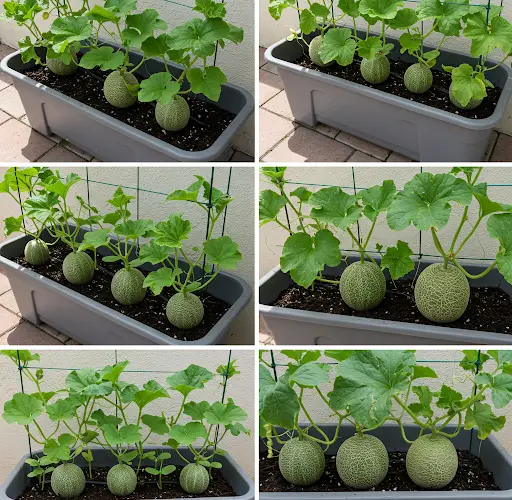Melons are a favorite summer fruit—refreshing, hydrating, and naturally sweet. But many home gardeners are intimidated by growing them, fearing they require lots of space, special care, or advanced knowledge. The truth is, with just a few simple steps, anyone can grow melons that are not only large and juicy but also incredibly sweet and satisfying.
This method is ideal for beginners and busy gardeners. It’s budget-friendly, low maintenance, and can be done even in small garden spaces or containers. Here’s how I consistently grow high-yield, sweet melons using a super simple approach.
1. Choosing the Right Variety
Start by selecting a variety suited to your climate and space. Some reliable and sweet varieties include:
-
Cantaloupe (Muskmelon) – sweet and aromatic
-
Honeydew – smooth skin and rich, mellow flavor
-
Sugar Baby Watermelon – perfect for small spaces
-
Golden Midget – small but intensely sweet, great for containers
Look for quick-maturing types if your growing season is short.
2. Start with Healthy Soil
Melons are heavy feeders, so fertile soil is the foundation of success. The ideal soil should be loose, well-drained, and rich in organic matter.
Prepare the planting bed or container with this mix:
-
40% garden soil
-
30% compost (homemade or store-bought)
-
20% aged manure or worm castings
-
10% rice husks or sand for aeration
Add a handful of crushed eggshells and wood ash to boost calcium and potassium, which help produce sweeter and firmer fruit.
If planting in containers, choose ones that are at least 15 inches deep and wide, with good drainage holes.
3. Seed Starting and Transplanting
Start seeds indoors or directly in the soil once temperatures reach 65–70°F (18–21°C).
Sow 2–3 seeds per spot, 1 inch deep. After sprouting, thin to the strongest seedling. When transplanting seedlings, be gentle with the roots and space plants at least 2 feet apart to give vines room to sprawl.
4. Boost Growth with a Natural Fertilizer Mix
This easy homemade fertilizer helps melons grow faster and taste sweeter. It’s made using natural kitchen waste:
Ingredients:
-
Banana peels (potassium)
-
Crushed eggshells (calcium)
-
Molasses or brown sugar (feeds soil microbes)
-
Fermented rice water (promotes root development)
Chop the peels and eggshells, place them in a bottle with a tablespoon of molasses and some rice water. Let it ferment for 3–5 days. Then dilute with water at a 1:10 ratio and apply to the soil every 10–14 days.
This blend improves fruit sweetness, encourages flowering, and strengthens plant immunity.
5. Mulch and Moisture Management
Melons need consistent moisture, especially during flowering and fruit development. However, overwatering can lead to rot.
To manage this:
-
Water deeply every 3–4 days during dry weather
-
Use organic mulch (dry grass, straw, or rice husks) around the base to retain moisture and suppress weeds
-
Avoid watering the leaves to prevent fungal issues
Once the fruits start to mature, reduce watering slightly to concentrate sugars in the fruit, resulting in better flavor.
6. Training and Supporting Vines
If you’re short on space, grow melons vertically using trellises. Use soft cloth slings to support the growing fruit and prevent them from breaking off. This also improves air circulation and keeps fruit off the ground, reducing rot and pest problems.
For ground planting, give vines plenty of room and guide them using sticks or string to avoid overcrowding.
7. Prune for Bigger Fruit
For larger melons, prune the plant to focus energy on fewer fruits. Once fruits start forming:
-
Leave only 2–3 fruits per vine
-
Remove excess side shoots that are not bearing fruit
-
Cut the vine tip after fruits have formed to direct nutrients toward ripening
This method results in fewer but much larger, sweeter melons.
8. Know When to Harvest
Melons will signal ripeness in different ways depending on the variety. General signs include:
-
A sweet fragrance at the base of the fruit
-
Slight softening near the stem
-
The tendril closest to the fruit drying out
-
A hollow sound when tapped (especially for watermelons)
Don’t leave ripe fruit on the vine too long—they may split or lose sweetness.
Final Thoughts
With just a few old containers, natural fertilizers, and simple techniques, you can grow melons that rival those from the farmer’s market. This super simple method doesn’t require expensive equipment, pesticides, or complicated tools—just patience, sunlight, and organic inputs you likely already have at home.
Start small with one or two plants, and soon you’ll be enjoying the rich rewards of fresh, sweet melons from your own backyard.




